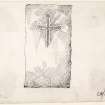Pricing Change
New pricing for orders of material from this site will come into place shortly. Charges for supply of digital images, digitisation on demand, prints and licensing will be altered.
Upcoming Maintenance
Please be advised that this website will undergo scheduled maintenance on the following dates:
Thursday, 9 January: 11:00 AM - 3:00 PM
Thursday, 23 January: 11:00 AM - 3:00 PM
Thursday, 30 January: 11:00 AM - 3:00 PM
During these times, some functionality such as image purchasing may be temporarily unavailable. We apologise for any inconvenience this may cause.
Mid Clyth, Roadside Farm, Cross Slab
Cross Slab (Early Medieval)
Site Name Mid Clyth, Roadside Farm, Cross Slab
Classification Cross Slab (Early Medieval)
Alternative Name(s) Greenhill West
Canmore ID 8603
Site Number ND23NE 5
NGR ND 2939 3728
Datum OSGB36 - NGR
Permalink http://canmore.org.uk/site/8603
- Council Highland
- Parish Latheron
- Former Region Highland
- Former District Caithness
- Former County Caithness
Mid Clyth 1, Caithness, cross-slab
Measurements: H 1.04m, W 0.58m, D 0.13m
Stone type: sandstone
Place of discovery: ND 2939 3728
Present location: built into a byre at Roadside Farm.
Evidence for discovery: found built into a stone dyke, the slab was built into a horse mill sometime before 1910. When the horse mill was dismantled in 1930, the stone was built into the corner of a byre.
Present condition: deteriorating from water damage.
Description
One face bears a pecked outline cross with circular terminals to the arms.
Date: eighth century.
Desk-based information compiled by A Ritchie 2016
Field Visit (1910)
ND23NE 5 2939 3728
At the farm of Roadside, Mid Clyth, occupied by Mr George Sinclair, is a cross-bearing slab. It was found many years ago built into a stone dyke, and has been used as a cover on the top of the wall around the well containing the machinery of the horse mill at the back of the house. On its upper face is rudely carved, or picked out, a small cross. The slab measures 3' 5" in length by 1' 11" in breadth, and 5" in thickness. The cross is 1' 5" in extreme length and 1' 2" in breadth across the centre. The arms are 6" long and terminate in round discs 2 1/2" in diameter; and the lateral arms are slightly inclined upwards. The stem is 9" long.
Visited by RCAHMS, 16th July 1910
Field Visit (10 May 1967)
This cross-inscribed slab, as described and illustrated by the RCAHMS, was removed from the horse mill at ND 2941 3728 when the mill was destroyed in 1930, and built into the corner of a new byre at ND 2939 3728 (information from A O Sinclair, Greenhill, Mid Clyth, Caithness). Its original position cannot be ascertained, but it probably came from the graveyard 180 m to the E, where a similar stone (ND23NE 4) stands on the site of a Roman Catholic chapel.
Surveyed at 1:2500.
Visited by OS (NKB), 10 May 1967.




















